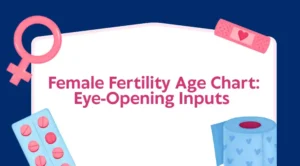Estrogen is an essential hormone in a female’s body. For the smooth functioning of the reproductive system, regulating the menstrual cycle, and initiating growth and development of sex organs. In general, many of us know estrogen is the primary hormone needed by women’s ovaries to complete the menstrual cycle. But estrogen has a lot more roles in a woman’s body.
What is the function of Estrogen?
Estrogen is one of the two main reproductive hormones in women. The other one is progesterone. Its essential functions are as follows:
- Brain development
- The reproductive system
- Development of secondary sexual characters
- Pelvic muscles
- Skin health ( by maintaining elastin & collagen, for a youthful glow, and natural bouncy skin).
Types of estrogen
Depending on what phase a woman is in, there are 3 types of estrogen:
- Estrone: This type is produced in the post-menopause stage.
- Estradiol: It is produced in a woman of childbearing age.
- Estriol: A pregnant woman’s body produces this type of estrogen.
A high level of estrogen is needed for the egg’s maturation and release and for the uterine wall’s thickening in case the egg is successfully fertilized.
High estrogen in women- What does it mean?
High levels of estrogen in women are clear indicators of hormonal imbalance. If its quantity shoots up, and a severe imbalance is created between estrogen and other hormones in the body, it is called Estrogen Dominance.
Now let’s understand some problems that are associated with excess estrogen levels:
- Abnormal growth or tumors in the adrenal gland, ovaries, etc.
- Excessive bleeding and painful periods.
- Cancer in the ovaries, breast, or endometrium.
- Polycystic ovarian syndrome (PCOS) etc.
What causes high estrogen levels in females?
High estrogen causes could be
- Natural Causes: Sometimes body itself has the tendency to produce more estrogen than normal. This may lead to the scaling up of estrogen in the body.
- Hormonal Contraceptives: From using a patch, pill, or ring the main aim of hormonal contraceptives is to alter the body’s natural hormonal balance. However, the change produced by these hormonal contraceptives is thought to trigger a high production of estrogen in women, leading to the imbalance that causes the exact symptoms they were trying to avoid: mood swings, acne, headache, and irregular periods.
- Medication: When women with symptoms of menopause undergo estrogen replacement therapy or other hormonal treatments to artificially compensate for the low estrogen production in the body, under the effect of these medications the level of estrogen can heighten to a problematic level.
- Low Progesterone: When the production of other hormones in the body is very low, it will lead to hormonal imbalance. The result will be a high level of estrogen as compared to progesterone.
- Liver disorder: Poor working of the liver, excess of harmful gut bacteria, digestion issues, etc., may hinder the proper functioning of the body and keep the quantity of estrogen under control. The liver performs the function of metabolizing estrogen and ejecting it from the body regularly.
- Bad food habits: Intake of too much alcohol affects the body’s efficiency in breaking estrogen into its components. This may result in the accumulation and increased levels of estrogen in the body.
- Stress: Stress regulation is an essential factor for hormonal balance. If the body is under high-stress conditions, it will produce cortisol for managing stress, inhibiting progesterone production in the body. This may result in estrogen dominance.
- Harmful toxins: As we know, there is excessive use of pesticides and other chemicals found in vegetables or fruits, eating the meat of animals treated with growth injections, etc. It can also interrupt hormonal balance in the body.
- Body Fat: Adipose tissue produces estrogen hormone. When there is excess fat in the body, the number of adipose tissues goes up, causing high estrogen secretion.
Signs and symptoms of high estrogen in women:
High estrogen levels in women come with a lengthy list of symptoms that you must notice and act on. These include:
- PMS, PCOS
- Bloating
- Fertility issues
- Ovarian cysts
- Irregular menstrual cycles
- Brain fog
- Development of fibrocystic lumps in the breasts
- Sudden weight gain
- Mood swings
How to diagnose high estrogen levels?
In case you experience any of these above-discussed conditions. It is suggested to visit a doctor. A blood test will be recommended to detect the estrogen levels in your body.
How to treat high estrogen in females?
It is suggested to keep a check on estrogen dominance. Since it can lead to many medical complications. Here is the most common line of treatment prescribed by doctors.
- Stress Management: In today’s lifestyle, it is almost impossible to avoid stress. But learning to manage and avoid unwanted stress can decrease the body’s production of cortisol and keep the estrogen and progesterone hormones well balanced.
- Healthy eating: Eating meals rich in fiber and avoiding high sugar and fat-containing meals will keep the liver healthy enough to carry out the breakdown process of estrogen easily.
- Reduce alcohol consumption: Consumption of alcohol is no good in any situation. Intake of alcohol hampers the functioning of life, thus leads to inhibit the exit of estrogen out of the body.
- Medication: To deal with high estrogen, doctors may prescribe aromatase inhibitors which stop the enzyme aromatase from converting androgen to estrogen.
- Surgery: If your case is severe or you have a family history of cancer-related to a high estrogen level, your doctor may recommend surgery to remove the ovaries. Overall, this option can help normalize the high levels of estrogen that may spur breast or ovarian cancer in your body.
Take away
While a woman’s body is vital to bear pressure and pains but she shouldn’t suffer unnecessarily. If you are facing such problems and want to seek help for high estrogen treatment. You can reach out to our team of experienced and skilled team of doctors at Endoworld Hospital. You will be guided in the best ways to deal with high levels of estrogen.





